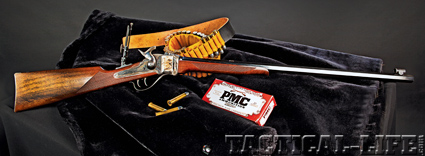The EMF Hartford Model 1874 Sharps Rifle is exact replica of the original Model 1874, right down to blued barrel, color case hardened receiver, and optional double set triggers.
The Model 1874 Sharps Rifle has been known by many names. Buffalo hunters called it “poison slinger.” Historians called it “The gun that shaped American destiny.” The company itself called the rifle “Old Reliable.” Whatever one chose to call it, the M1874 Sharps played a significant role in American history and the American West. In the wake of the popular film Quigley Down Under, interest has been resurgent regarding Sharps rifles in general and the M1874 in particular. Several manufacturers now produce Sharps replicas. Most of them are custom-built rifles that entail not only a waiting period but also significant expense.
History
The original Sharps 1874 was actually introduced in 1871, but the model number changed when new owners purchased the company in 1874. Presumably, this was intended to show prospective purchasers of Sharps rifles that the company had something new to offer. Whatever the reason, the Sharps dominated the single-shot rifle market in the latter part of the 19th Century. There were other rifles such as the Ballard, the Springfield 1873, and Remington Rolling Blocks. The vast majority of frontiersmen who chose a large caliber rifle opted for the Sharps.
Advertisement — Continue Reading Below
There were many reasons for this, not the least of which the rifle’s accuracy. Readers may be familiar with Matthew Quigley’s seemingly astonishing long-distance shot early in Quigley Down Under. Shots such as this were fairly routine for buffalo hunters of the American West. Probably the most famous use of a Sharps was by Billy Dixon when approximately 100 Cheyenne and Comanche Indians attacked a buffalo hunters’ camp at Adobe Wells in the Texas Panhandle. Dixon, using a borrowed .50-90 Sharps, brought down an Indian at the incredible range of 1,538 yards. In addition to accuracy, most of its competitors were not nearly as aesthetically pleasing as the Sharps. Even today, the rifle’s proportions and lines are appealing to anyone who appreciates firearms.
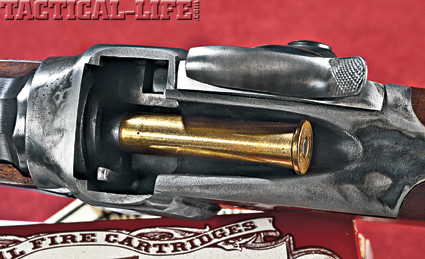
Loading involves placing hammer on half cock, dropping the block using trigger- guard/lever. If a spent cartridge is in the chamber, it will be extracted.
Advertisement — Continue Reading Below
Chambering
What set the Sharps 1874 apart from most others was the ammunition for which it was chambered. The Sharps action is inherently strong and can stand the pressures that would cause the ruination of other rifles like the “Trapdoor” Springfield. Indeed, the “hot” PMC ammunition, one of the rounds tested herein, specifically cautions against its use in Trapdoor Springfields. Probably the most popular caliber for the buffalo hide hunters was the .50-90, basically a lengthened .50-70. Another extremely popular chambering was the .44-90, in essence a necked down .50-90 firing a 520-grain bullet. Because most plains hunters reloaded their ammunition with varying amounts of black powder to save money, cartridges like the .50-90 were not always referred to as such. The .50-90 was also called the .50-100 and .50-110.
For this reason, the standard cartridges were referred to by caliber and case length with most Sharps rifles marked as such. The .50-90, for example, was designated .50-2½. Most cartridges for Sharps rifles were bottlenecked; the only ones which were not were the .45-70, .50-70, and .50-90. In calibers that included .40, .44, .45, and .50, Sharps rifles were used to virtually exterminate the American Bison between 1870 and 1900. Railroad guards, scouts and law enforcement agencies, most notably the Texas Rangers, also used Sharps rifles.
Sharps 1874s ranged from 10 to 16 pounds and were referred to by their weight. Writing in 1874 at Fort Worth, Texas, Frank Collinson alluded to the “12-pound Sharps rifle” he had recently purchased.
Weight
This was about average for the rifle in its early days, although 16-pound models were noted from time to time. Later models increased in average weight to some 14 pounds, although Sharps would build a rifle to whatever specifications the purchaser desired. (Our test rifle was relatively lightweight, tipping the scales at a mere 10.5 pounds.) All the purchaser had to do was lay down his money. Some “high end” Creedmoor Model Sharps retailed at $125, an incredible expense in the 1870s. Sharps “Hunting Models” were significantly less. The least expensive selling for $30, still a fairly expensive rifle for the time.
Advertisement — Continue Reading Below
Barrel
This model had a 26-inch, round barrel. The Sharps “Sporting Rifle” with full octagon barrel began at $35, while the half octagon-barreled model listed for $33. Double set triggers were a $4 option, while globe and peep sights added $5 to the rifle’s price. A telescopic sight would cost the Sharps buyer $40 – more than the cost of the rifle in many cases. Sharps also made and sold a full line of rifle cases with leather cases ranging from $2 to $5 and wood from $7 to $40, depending on type of wood and interior trim. A canvas case was available for only $2.50. Oddly, a sheepskin case cost 50 cents less.
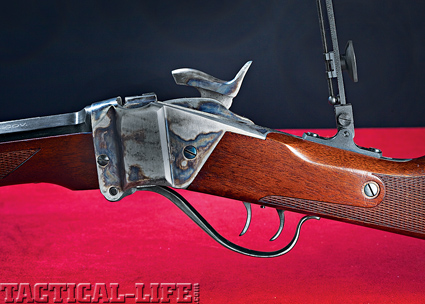
Hartford Sharps receiver area. Author added tang adjustable rear sight and globe front with replaceable inserts. 19th Century buffalo hunters equipped their rifles with sights such as these for long range work.
Advertisement — Continue Reading Below
Decline & Renaissance
Despite the popularity of Sharps rifles, the company collapsed in 1881. By this time, repeating rifles were being manufactured in calibers that approached the power of those for which the Sharps was chambered . This no doubt was at least partially responsible for a decline in the demand for single-shot rifles in “major” calibers. Over the years since the demise of the Sharps Rifle Company attempts were made to resurrect the 1874 and the later hammerless 1878 model. The latter Sharps had a sophisticated striker firing mechanism designed by Hugo Borchardt. Borchardt later designed the pioneering semiautomatic pistol that bore his name and led to the development of the famous Luger pistol.
There are several reasons for the current popularity of the Sharps and a few other single-shot rifles whose heyday was over 130 years ago. One is Cowboy Action Shooting. This sport has driven a newfound interest in firearms of the American Frontier that approaches mania in many enthusiasts. Of course, the popularity of the movie Quigley Down Under has had something to do with the popularity of Sharps rifles in general. A spin-off of cowboy action shooting is matches devoted solely to Sharps rifles and other single-shot rifles of the late 19th Century.
Nostalgia
Regardless, there is just something about the Sharps that captures the imagination. Whether it is nostalgia over the cowboy movies of one’s youth, a fascination with American history and the guns of the old West, long-range shooting in general, or simply an appreciation of quality and manufacturing processes that have long since ceased to be a part of firearms manufacture, there appears to be a small but steady demand for Sharps rifles. To meet this demand, a number of custom makers ply their trade here in the United States.
Advertisement — Continue Reading Below
Replicas
Most cannot build their Sharps replicas in sufficient numbers to meet demand and these rifles, characterized by Wells and Shiloh Sharps, represent the “high end” of Sharps rifles—essentially those that would have cost $125 in 1875. These rifles are made with tender loving care by craftsmen who use the finest wood and steel to craft rifles on par with the best to be found anywhere. For the individual who does not wish to spend nearly $2,000 for a single-shot rifle, there are alternatives. One of these is the line of Sharps replicas offered by EMF.
EMF Sharps
EMF Sharps replicas are made in Italy by Davide Pedersoli Company. They do not take a back seat to anyone in overall care in manufacture, if the example we purchased is any indication. The fit of wood and metal is about as good as it gets in a production firearm, with a near-perfect match between all metal and wood interfaces. The bluing is deep and even while the receiver’s color casehardening is extremely well done. The walnut is straight, dense grain and the checkering even and sharp. The care that went into the manufacture of this rifle is obvious. Screw heads are aligned on the receiver tang, buttplate and forearm. The muzzle is deeply crowned. All in all, it is a beautiful rifle.
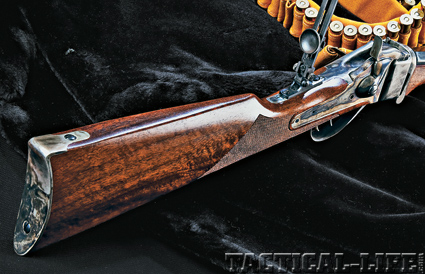
Advertisement — Continue Reading Below
Color casehardened finish on the buttplate is wonderfully done and the walnut stock is attractive.
The EMF Hartford Model Sharps rifles was available in four versions. All of which essentially replicate the original 1874 Sporting Model with 28-inch full octagon barrel and double set triggers. The rifles were offered with one of three finishes – blue barrel, brown barrel or unfinished “in the white.” A 22-inch round barreled military carbine and 28-inch “Business Rifle” were also offered. Calibers include .45-70 and .45-120. At the high end, three variants – the “Quigley” (that replicates the movie rifle), the Deluxe Premier (with select walnut, fancy color casehardening and German silver forend cap) and the Deluxe Engraved Premier (which adds the finest walnut, hand engraving and gold inlay to the Premier rifle). These rifles were claimed to be the equal of any high-quality Sharps replica rifle at a far lower price.
Triggers
All EMF Sharps rifles except the military carbine have double-set triggers. The standard trigger on our test rifle was quite heavy at about 12 pounds. It broke cleanly, while the set trigger breaks at only a pound or slightly less. We averaged 1.1 pounds set trigger pull. This is so light that all one has to do is think about squeezing the trigger before the bullet heads downrange. Sights are almost identical to those of the original 1874 rifles, with a leaf rear and blade front inletted into a dovetail in the barrel. We added a tang peep rear sight and globe front to more closely replicate an original buffalo hunter’s rifle.
Advertisement — Continue Reading Below
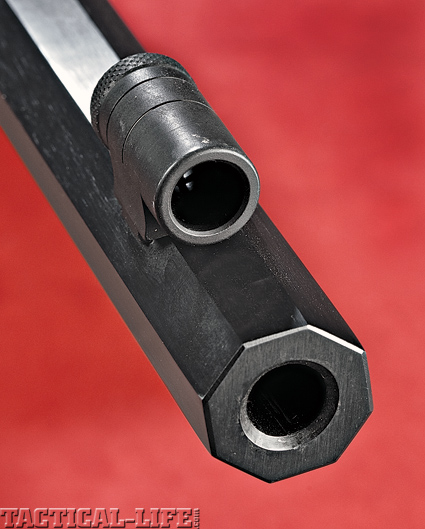
Note deep crown and globe front sight with insert.
Range Time
Our particular EMF came with the 28-inch octagon barrel weighing in at 10 pounds, 5 ounces—actually on the light side for a Sharps. The barrel was 7/8 of an inch in diameter and measured 3/8 of an inch across the flats. The muzzle was nicely crowned with the bore slightly recessed for protection. As a neophyte to shooting a rifle such as this, we originally obtained some “Cowboy” .45-70, from both Black Hills and PMC, but found this to be somewhat “wimpy.” Our friend Jeff Hoffman at Black Hills who told us that cowboy ammo is intended only for cowboy competition and as such isn’t loaded to very high pressure.
Advertisement — Continue Reading Below
In fact, the factory velocity of Black Hills “cowboy” .45-70 is loaded to deliver only 1250 feet per second (fps) muzzle velocity, as is PMC’s cowboy load. These are lower velocity than the original factory loads, which were about 1440 fps. So we set out to find some stouter loads for our Sharps. One load came from PMC, which recently introduced a high-pressure .45-70 strictly for modern rifles. This cartridge launches a 350-grain flat nose soft point bullet at a whopping 2,025 fps.
Although we knew the EMF rifle to be made of modern high-quality steel and the Sharps action is inherently strong. Winchester manufactures a load that is almost as potent, so we obtained some of that as well. Winchester’s SPG4570 launches a 300-grain Partition Gold bullet at 1880 fps, good enough for just about anything on four legs that roams the backwoods of North America.
Final Notes
Our range testing extended to “only” 100 yards. Cowboy shooting is conducted at distances from 50 to 500 yards, depending on the match. We should note that the EMF Sharps version evaluated herein is no longer offered by the company, but check the used markets or take a look at EMF’s current Sharps rifles: Sharps Business Rifle, Billy Dixon Rifle, EMF Silhouette Rifle and Quigley Sporting Rifle.
Sharps rifles have always had a reputation for reliability and accuracy and our test rifle didn’t disappoint. The rifle was a solid minute of angle at 100 yards with all ammo tested – Black Hills, PMC, and Winchester. The bottom line is that the EMF 1874 Sharps replica was a high-quality faithful reproduction of a classic American rifle that was an integral part of the 19th Century westward expansion.
